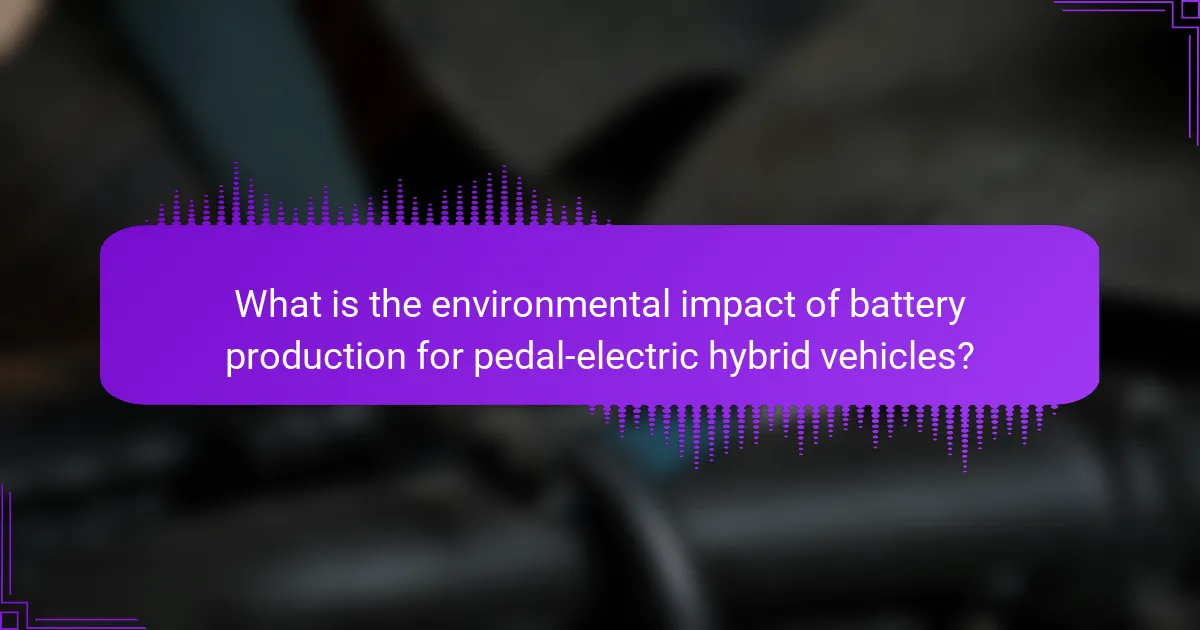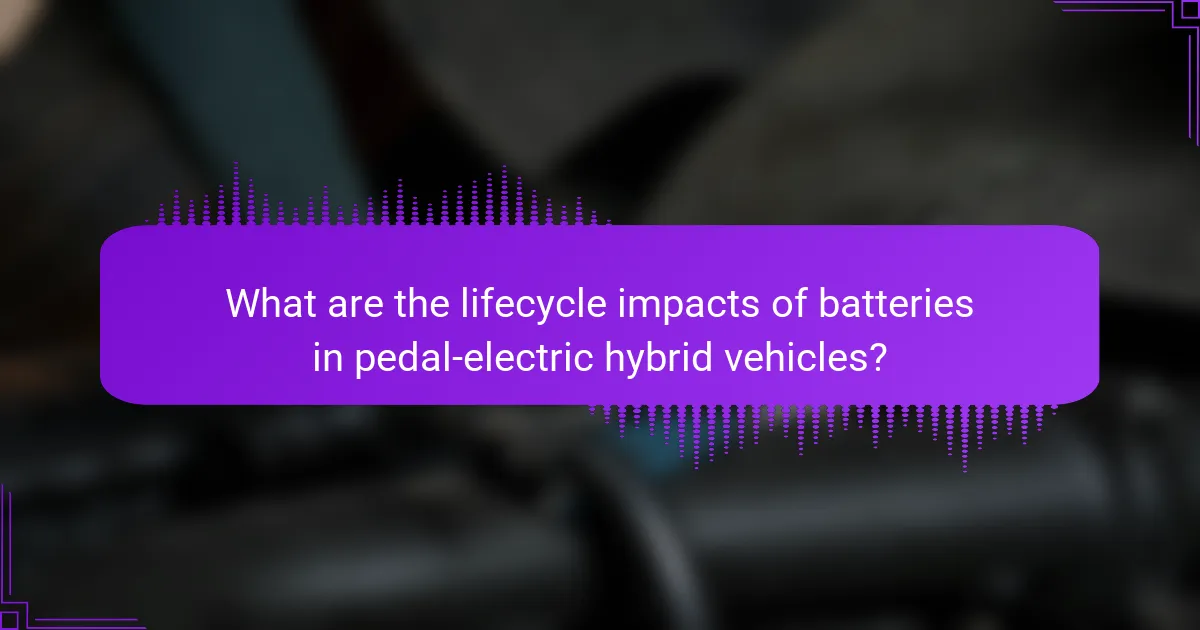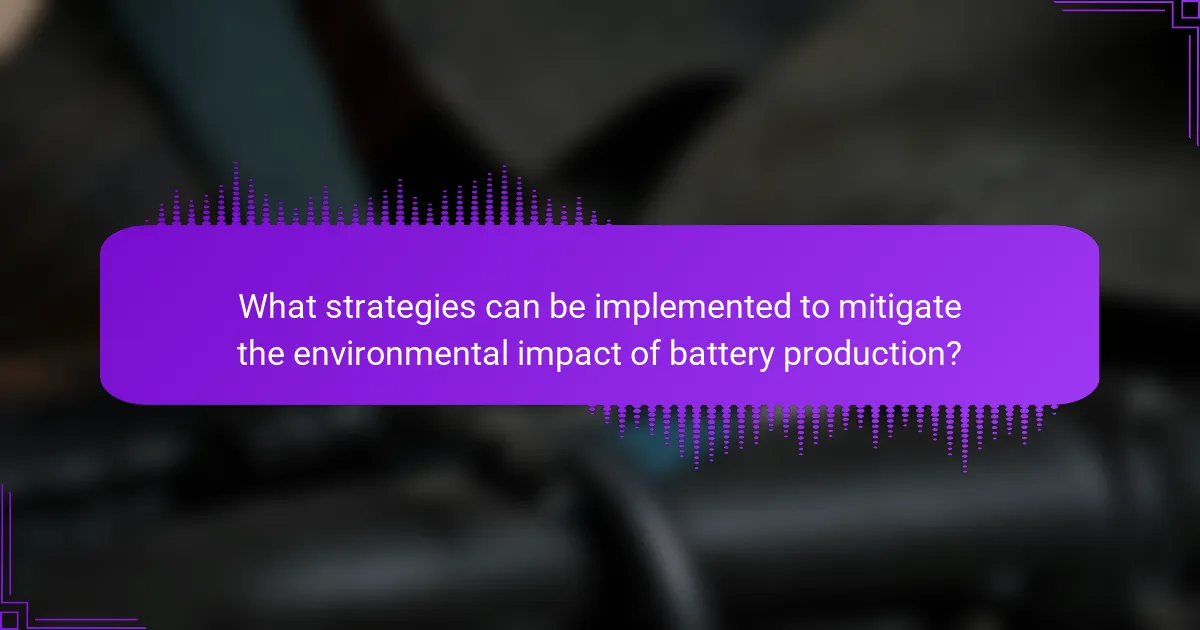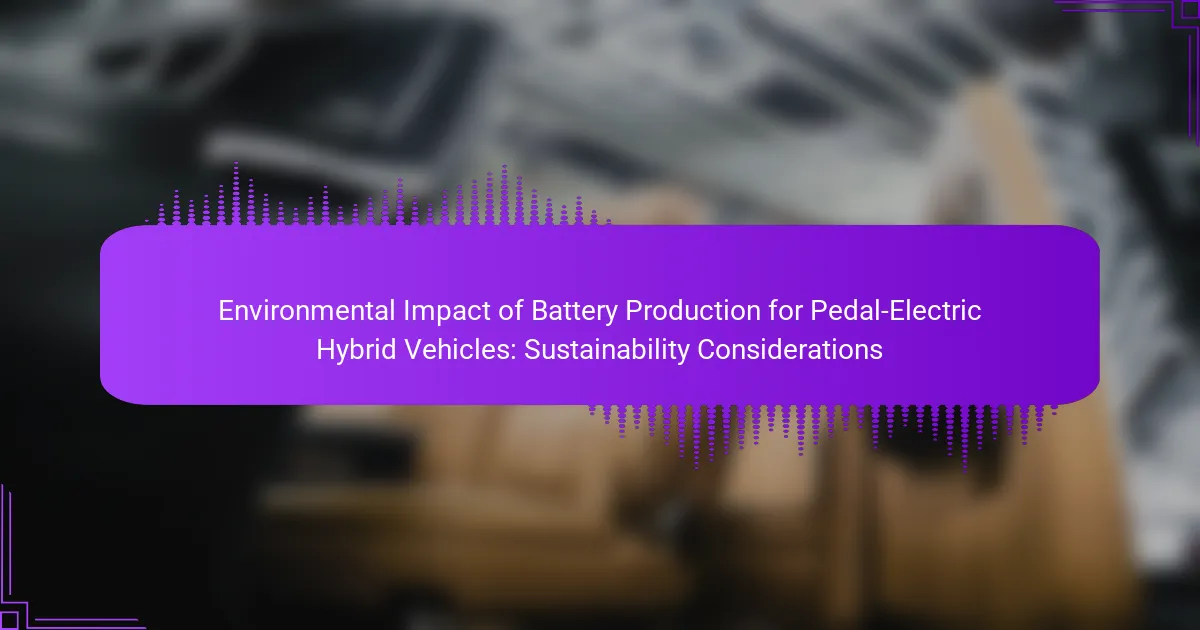
What is the environmental impact of battery production for pedal-electric hybrid vehicles?
Battery production for pedal-electric hybrid vehicles has significant environmental impacts. The extraction of raw materials, such as lithium, cobalt, and nickel, can lead to habitat destruction and water pollution. Manufacturing processes often consume large amounts of energy, contributing to greenhouse gas emissions. Recycling rates for batteries remain low, resulting in increased waste and resource depletion. Studies indicate that the carbon footprint of battery production can be substantial, with estimates ranging from 150 to 200 kg of CO2 per kWh of battery capacity. Additionally, improper disposal of batteries poses risks to soil and water quality due to toxic materials. Overall, while pedal-electric hybrid vehicles reduce emissions during use, the environmental impact of battery production is a critical consideration in their lifecycle.
How does battery production affect natural resources?
Battery production significantly affects natural resources through the extraction of raw materials. Key resources include lithium, cobalt, and nickel, which are essential for battery manufacturing. The mining processes for these materials often lead to habitat destruction and soil degradation. For instance, lithium extraction requires large amounts of water, impacting local water supplies. Cobalt mining can result in toxic waste, contaminating surrounding ecosystems. Furthermore, the demand for these materials has led to increased mining activities, straining natural resources. According to a study by the International Energy Agency, the demand for lithium could increase by over 40 times by 2040, highlighting the urgent need for sustainable practices in battery production.
What raw materials are used in battery production?
Lithium, cobalt, nickel, and graphite are the primary raw materials used in battery production. Lithium is essential for lithium-ion batteries, which are commonly used in electric vehicles. Cobalt enhances battery stability and energy density. Nickel increases energy capacity, allowing for longer driving ranges. Graphite serves as the anode material in these batteries. According to a report by the International Energy Agency, the demand for these materials is expected to rise significantly due to the increasing adoption of electric vehicles.
How does the extraction of these materials impact the environment?
The extraction of materials for battery production significantly impacts the environment. It leads to habitat destruction, as mining operations often clear large areas of land. This loss of habitat can threaten local wildlife and biodiversity. Additionally, the extraction process can result in soil and water contamination from toxic substances. For example, lithium mining can pollute groundwater, affecting local communities. Air pollution is another consequence, as dust and emissions from mining activities can degrade air quality. Furthermore, the carbon footprint associated with extraction contributes to climate change. According to a study by the International Energy Agency, mining and processing minerals for batteries can account for up to 30% of the total emissions in the battery life cycle. These factors highlight the critical environmental challenges associated with material extraction for battery production.
What are the emissions associated with battery production?
Battery production is associated with significant emissions, primarily carbon dioxide (CO2). The production of lithium-ion batteries, commonly used in hybrid vehicles, generates approximately 150 to 200 kg of CO2 per kWh of battery capacity. This high emission level results from mining, refining, and processing raw materials like lithium, cobalt, and nickel. Additionally, the energy-intensive manufacturing processes contribute to greenhouse gas emissions. According to a study by the International Council on Clean Transportation, battery production emissions can account for 30% to 40% of the total lifecycle emissions of electric vehicles. Therefore, the environmental impact of battery production is a critical consideration in evaluating the sustainability of hybrid vehicles.
What types of emissions are generated during production?
During the production of batteries for pedal-electric hybrid vehicles, several types of emissions are generated. These include greenhouse gases, particularly carbon dioxide (CO2), methane (CH4), and nitrous oxide (N2O). The battery manufacturing process often involves the extraction and processing of raw materials, which can release significant amounts of CO2. For instance, lithium extraction emits around 15 to 20 tons of CO2 per ton of lithium produced. Additionally, the energy used in battery production typically comes from fossil fuels, further contributing to CO2 emissions. Other emissions may include volatile organic compounds (VOCs) and particulate matter, which can arise from chemical processes and manufacturing equipment. These emissions impact air quality and contribute to climate change.
How do these emissions compare to traditional vehicle production?
Emissions from battery production for pedal-electric hybrid vehicles are generally higher than those from traditional vehicle production. Battery manufacturing processes often involve energy-intensive steps, leading to increased greenhouse gas emissions. For example, producing lithium-ion batteries can emit approximately 150 to 200 kg of CO2 equivalent per kWh of battery capacity. In contrast, traditional vehicle production emits around 100 kg of CO2 equivalent per vehicle. Additionally, the extraction and processing of raw materials for batteries contribute significantly to emissions. Studies indicate that battery production can result in up to 40% higher emissions compared to conventional vehicle manufacturing.
What are the sustainability considerations in battery production?
Sustainability considerations in battery production include resource extraction, energy consumption, and waste management. The extraction of materials like lithium and cobalt can lead to environmental degradation and social issues. Energy-intensive processes are often powered by fossil fuels, contributing to greenhouse gas emissions. Additionally, end-of-life battery disposal poses challenges, as improper handling can result in toxic leakage. Recycling initiatives can mitigate these impacts by recovering valuable materials and reducing the need for new resource extraction. According to a 2021 study by the International Energy Agency, recycling could provide up to 30% of lithium demand by 2030, highlighting its importance in sustainable practices.
How can battery production be made more sustainable?
Battery production can be made more sustainable through several key practices. First, utilizing recycled materials reduces the need for virgin resources. For instance, recycling lithium-ion batteries can recover up to 95% of lithium, cobalt, and nickel. Second, adopting renewable energy sources in manufacturing processes minimizes carbon emissions. Studies show that using solar or wind energy can decrease the carbon footprint by 30%. Third, improving battery design for longevity and efficiency can extend their lifecycle. Longer-lasting batteries reduce the frequency of replacements, thus lowering overall production demand. Lastly, implementing stricter regulations on mining practices ensures that environmental standards are met. This approach mitigates habitat destruction and water pollution associated with raw material extraction.
What role do recycling and second-life applications play?
Recycling and second-life applications play a crucial role in mitigating the environmental impact of battery production for pedal-electric hybrid vehicles. Recycling allows for the recovery of valuable materials, such as lithium, cobalt, and nickel, which can be reused in new batteries. This process reduces the need for raw material extraction, which is often environmentally damaging.
Second-life applications extend the lifespan of batteries by repurposing them for less demanding uses, such as energy storage in renewable energy systems. This not only maximizes the utility of the batteries but also delays their entry into waste streams. Studies show that effective recycling can recover up to 95% of battery materials, significantly lowering the carbon footprint associated with battery production.
By integrating recycling and second-life applications, the overall sustainability of pedal-electric hybrid vehicles is enhanced, contributing to a circular economy in the battery industry.

What are the lifecycle impacts of batteries in pedal-electric hybrid vehicles?
The lifecycle impacts of batteries in pedal-electric hybrid vehicles include resource extraction, production emissions, usage efficiency, and end-of-life disposal. Resource extraction for battery materials, such as lithium and cobalt, can cause significant environmental degradation. The production phase generates greenhouse gas emissions, contributing to climate change. During usage, pedal-electric hybrid vehicles improve fuel efficiency and reduce overall emissions compared to conventional vehicles. However, battery performance can degrade over time, impacting efficiency. At the end of their lifecycle, batteries require proper recycling to mitigate toxic waste and recover valuable materials. Studies indicate that recycling can reduce the environmental footprint by reclaiming up to 95% of battery materials.
How does battery usage affect overall vehicle emissions?
Battery usage significantly reduces overall vehicle emissions. Electric and hybrid vehicles produce fewer tailpipe emissions compared to traditional gasoline vehicles. The use of batteries allows for electric propulsion, which can be powered by renewable energy sources. Studies show that electric vehicles emit 40% to 70% less CO2 over their lifetime than conventional vehicles. Battery efficiency and the source of electricity used for charging play critical roles in determining emission levels. Additionally, the lifecycle emissions from battery production must be considered. However, advancements in battery technology continue to lower these emissions over time.
What are the long-term environmental benefits of using pedal-electric hybrid vehicles?
Pedal-electric hybrid vehicles significantly reduce greenhouse gas emissions over the long term. These vehicles combine human power with electric assistance, leading to lower fuel consumption. A study by the International Council on Clean Transportation found that hybrid vehicles emit 30-50% less CO2 compared to traditional gasoline cars.
Additionally, they decrease reliance on fossil fuels. This shift contributes to energy sustainability and reduces air pollution. The use of pedal-electric hybrids can lead to improved urban air quality. Furthermore, they promote the use of renewable energy sources when charged with clean electricity.
Over time, the cumulative effect of these vehicles can lead to a substantial decrease in the overall carbon footprint of transportation. This transition supports global efforts to combat climate change effectively.
How do charging methods influence battery lifecycle impacts?
Charging methods significantly influence battery lifecycle impacts by affecting the efficiency and longevity of the battery. Fast charging can generate excess heat, which may degrade battery materials, leading to a shorter lifespan. Conversely, slower charging methods typically produce less heat and can enhance battery longevity. Research indicates that batteries charged at optimal rates can maintain up to 80% of their capacity after 500 charge cycles. Additionally, charging frequency and depth of discharge are critical factors. Shallow discharges and fewer charge cycles contribute to a reduced environmental footprint. Therefore, the choice of charging method directly correlates with the overall sustainability of battery use in pedal-electric hybrid vehicles.
What are the end-of-life considerations for batteries?
End-of-life considerations for batteries include safe disposal, recycling, and environmental impact. Batteries contain hazardous materials that can harm ecosystems if not properly managed. Safe disposal methods prevent leakage of toxic substances. Recycling batteries recovers valuable materials like lithium and cobalt. This process reduces the need for new raw materials. Regulations often mandate specific recycling practices for battery types. Consumers should follow local guidelines for battery disposal. Proper end-of-life management minimizes environmental risks and promotes sustainability.
What are the best practices for battery disposal and recycling?
The best practices for battery disposal and recycling include utilizing designated recycling centers. These centers are equipped to handle various battery types safely. Many retailers also offer battery take-back programs for consumers. It is essential to keep batteries out of regular trash to prevent environmental contamination. Local regulations often dictate specific disposal methods for batteries. Checking with local waste management authorities can provide guidance on proper disposal. The Environmental Protection Agency (EPA) states that recycling batteries can recover valuable materials and reduce landfill waste. Following these practices helps minimize the environmental impact of battery production and disposal.
How do regulations impact battery end-of-life processes?
Regulations significantly influence battery end-of-life processes by establishing guidelines for safe disposal and recycling. These regulations ensure that hazardous materials are managed properly to prevent environmental contamination. For instance, the European Union’s Battery Directive mandates that batteries must be collected and recycled to minimize waste. Compliance with such regulations encourages manufacturers to design batteries that are easier to recycle. Additionally, regulations can provide incentives for companies to invest in sustainable practices. This leads to improved recovery rates of valuable materials, such as lithium and cobalt. Overall, regulations drive the development of more environmentally friendly end-of-life solutions for batteries.

What strategies can be implemented to mitigate the environmental impact of battery production?
Implementing strategies to mitigate the environmental impact of battery production involves several key approaches. First, adopting sustainable sourcing of raw materials is essential. This includes using recycled materials and reducing the need for mining. Second, improving energy efficiency during production can significantly lower carbon emissions. Utilizing renewable energy sources, like solar and wind, in manufacturing processes is crucial. Third, enhancing battery design for longevity reduces waste and the frequency of replacements. Fourth, developing closed-loop recycling systems can recover valuable materials from used batteries. Finally, investing in research for alternative battery technologies can lead to less harmful production methods. These strategies collectively aim to minimize the ecological footprint of battery manufacturing.
How can manufacturers improve their practices?
Manufacturers can improve their practices by adopting sustainable sourcing of materials. This includes utilizing recycled materials and reducing reliance on rare earth elements. Implementing energy-efficient production processes can also minimize environmental impact. For instance, using renewable energy sources can lower carbon emissions significantly. Regular audits and assessments of supply chains can identify inefficiencies and areas for improvement. Collaboration with stakeholders can foster innovative solutions for sustainability. Research indicates that companies adopting these practices can enhance their market competitiveness while reducing their ecological footprint.
What innovations are being explored in battery technology?
Innovations in battery technology include solid-state batteries, lithium-sulfur batteries, and advanced recycling methods. Solid-state batteries utilize a solid electrolyte, enhancing energy density and safety. Lithium-sulfur batteries offer higher capacity and lower costs compared to traditional lithium-ion batteries. Advanced recycling methods aim to recover valuable materials from used batteries, reducing environmental impact. Research indicates that these innovations could significantly improve battery performance and sustainability in electric vehicles. For example, solid-state batteries can potentially increase energy density by 50% compared to current technologies.
How can supply chain transparency enhance sustainability?
Supply chain transparency enhances sustainability by providing visibility into sourcing and production practices. This visibility allows companies to identify and mitigate environmental impacts. It enables consumers to make informed choices based on ethical standards. Transparency fosters accountability among suppliers, encouraging them to adopt sustainable practices. A study by the World Economic Forum found that companies with transparent supply chains reduce waste by up to 20%. Furthermore, transparency can lead to improved resource efficiency and reduced carbon footprints. By sharing information about materials and processes, businesses can collaborate on sustainability initiatives. Overall, transparency is crucial for building trust and advancing sustainability goals in the supply chain.
What can consumers do to support sustainable battery production?
Consumers can support sustainable battery production by choosing products from companies that prioritize eco-friendly practices. They should research brands that utilize recycled materials in battery manufacturing. Supporting local businesses can reduce transportation emissions associated with battery distribution. Consumers can also participate in battery recycling programs to ensure proper disposal and reuse of materials. Advocating for policies that promote sustainable mining practices is another effective action. Additionally, purchasing energy-efficient devices can lessen overall battery demand. Educating themselves about the environmental impacts of battery production will empower consumers to make informed choices.
How can consumers make informed choices regarding pedal-electric hybrid vehicles?
Consumers can make informed choices regarding pedal-electric hybrid vehicles by researching their environmental impact. Understanding the sustainability of battery production is crucial. Consumers should look for certifications that indicate eco-friendly manufacturing processes. Evaluating the vehicle’s energy efficiency ratings helps assess its overall sustainability. Comparing the lifecycle emissions of different models provides insight into their environmental footprint. Reading consumer reviews and expert analyses can offer additional perspectives on performance and reliability. Finally, considering the availability of recycling programs for batteries can influence the decision-making process.
What role does consumer demand play in shaping battery production practices?
Consumer demand significantly influences battery production practices. As consumers increasingly prioritize sustainability, manufacturers adapt their processes to meet these expectations. A rise in demand for eco-friendly products leads to innovation in battery technologies. Companies invest in research to develop batteries with lower environmental impacts. For instance, the shift towards lithium-ion batteries reflects consumer preferences for higher efficiency and reduced waste. Furthermore, consumer interest in electric vehicles drives the need for scalable battery production. According to a report by the International Energy Agency, global demand for electric vehicle batteries is projected to increase substantially by 2030. This demand compels manufacturers to optimize supply chains and sourcing of raw materials. Ultimately, consumer preferences shape the direction and methods of battery production in response to environmental concerns.
What are the future trends in battery production sustainability?
Future trends in battery production sustainability include increased use of recycled materials and advancements in battery chemistry. Manufacturers are focusing on circular economy practices to minimize waste. The adoption of lithium-ion battery recycling is expected to rise, reducing the demand for virgin materials. Innovations in solid-state batteries may lead to safer and more efficient energy storage. Research shows that solid-state batteries have the potential to improve energy density and reduce environmental impact. Additionally, companies are investing in renewable energy sources for battery manufacturing processes. This shift aims to lower carbon emissions associated with production. Overall, sustainable practices in battery production are becoming essential for meeting global energy demands.
How are emerging technologies influencing battery production?
Emerging technologies are significantly influencing battery production by enhancing efficiency and sustainability. Innovations such as solid-state batteries promise higher energy densities and improved safety compared to traditional lithium-ion batteries. Automation in manufacturing processes reduces waste and increases precision, leading to lower production costs. Advanced materials, like silicon anodes, improve battery performance and lifespan. Additionally, artificial intelligence optimizes supply chain management, ensuring better resource allocation. Research indicates that these advancements can reduce carbon emissions associated with battery production by up to 30%. Overall, emerging technologies are reshaping the battery production landscape, making it more efficient and environmentally friendly.
What collaborative efforts are being made to enhance sustainability in the industry?
Collaborative efforts to enhance sustainability in the battery production industry include partnerships between manufacturers, researchers, and environmental organizations. These collaborations aim to develop more sustainable materials and recycling processes. For instance, companies are working together to create closed-loop systems for battery recycling. This reduces waste and conserves resources. Research initiatives focus on improving battery efficiency and lifespan, which lowers environmental impact. Additionally, industry coalitions are advocating for stricter environmental regulations. They emphasize the importance of sustainable sourcing of raw materials. These collective actions demonstrate a commitment to reducing the ecological footprint of battery production for pedal-electric hybrid vehicles.
What practical tips can be adopted for sustainable battery usage?
To promote sustainable battery usage, individuals should follow several practical tips. First, charge batteries only when necessary. Overcharging can reduce battery lifespan. Second, avoid extreme temperatures. Heat and cold can negatively impact battery performance. Third, use energy-efficient charging practices. This includes unplugging chargers when not in use. Fourth, recycle batteries properly. Recycling can prevent harmful chemicals from entering the environment. Fifth, consider using renewable energy sources for charging. This reduces the carbon footprint associated with electricity generation. Lastly, store batteries in a cool, dry place to maintain their health. These practices contribute to longer battery life and reduced environmental impact.
The main entity of the article is the environmental impact of battery production for pedal-electric hybrid vehicles. The article examines the significant environmental challenges associated with battery production, including resource extraction, emissions during manufacturing, and end-of-life disposal issues. It highlights key raw materials used in battery production, such as lithium, cobalt, and nickel, and discusses their detrimental effects on natural resources and ecosystems. The article also explores sustainability considerations, innovative practices for reducing environmental impact, and the role of consumer demand in shaping battery production practices. Overall, it emphasizes the need for sustainable solutions in the battery lifecycle to enhance the ecological footprint of hybrid vehicles.
